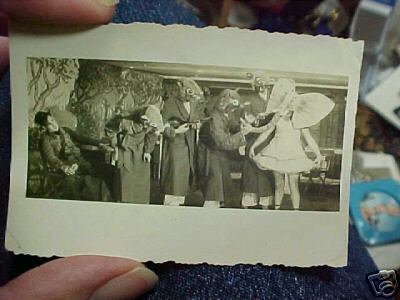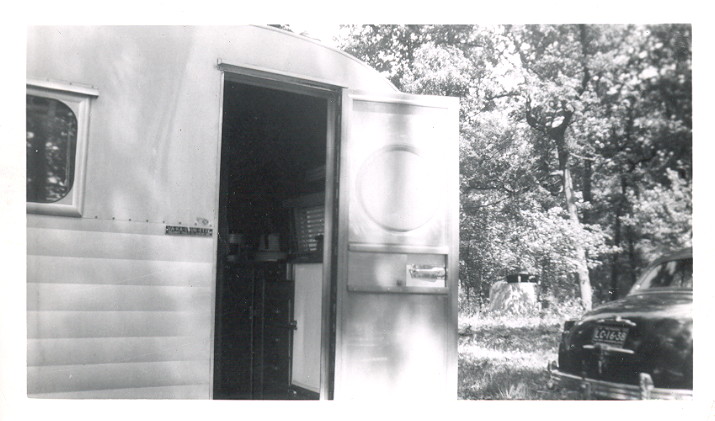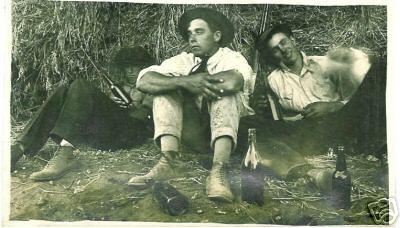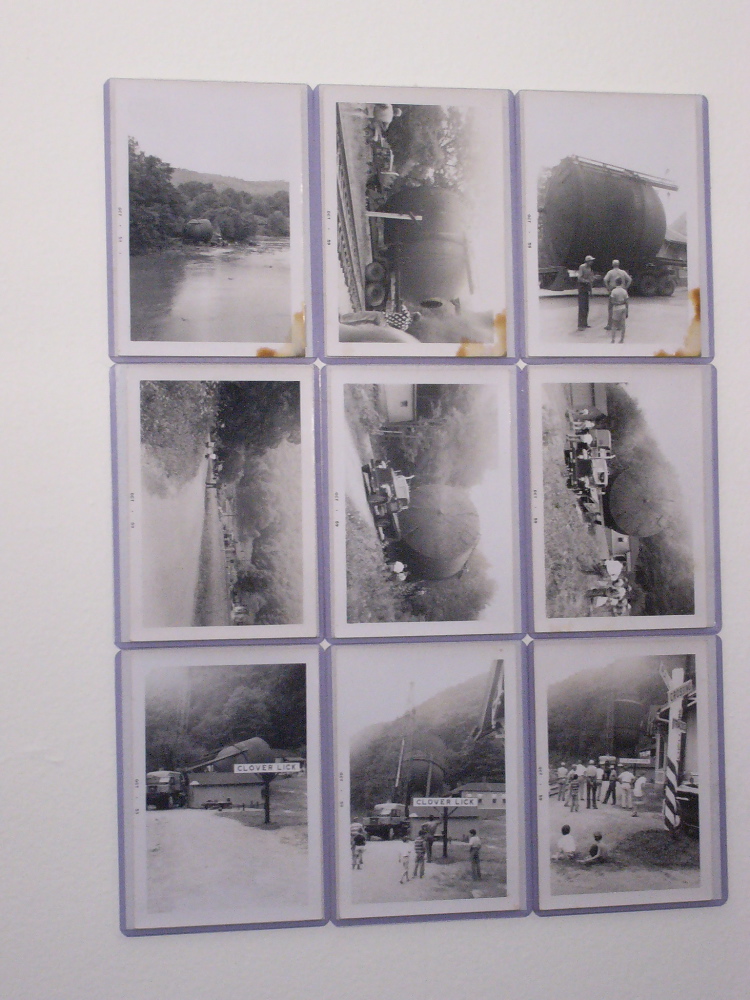Schwarz
View current page
...more recent posts
"It's truly the most vulgar thing I have ever seen in my entire life," said Jennie Farrell, whose brother James, 26, an electrician, died on the 105th floor of the south tower.
"To call it art is reprehensible, and to place it at Ground Zero is committing a second criminal act against our dead," she added.
"It's offensive, it's America-bashing, it's a despicable insult to the families of people defending us in Iraq, and I'm sick and tired of it," said Jack Lynch, who helped carry the body of his firefighter son Michael, 30, out of the rubble.
"On 9/11, the families were violated by terrorists. Now we're being violated all over again, and it brings 9/11 right back home to each of us."
congratulations to our friend and jersey city artist amy
wilson for stirring up some real shit on the front page of the daily news!
and jetblue has wifi in the waiting area. no sign of alex yet.
The work of a Rotterdam design collective called Studio Sputnik, Snooze extends the inquiry begun a generation ago by architects like Robert Venturi, Denise Scott Brown and Steven Izenour, in Learning from Las Vegas, and continued more recently by Lars Lerup, in After the City — the exploration of how architecture, so long a redoubt of high culture, might interact with popular culture and mass media. Or, as the authors put it, right at the start: "The lifestyle magazine Wallpaper* has a clever title. The asterisk refers to the subtitle: 'the stuff that surrounds you.' That is what this book is about: the spatial environment as a sum of the stuff that surrounds you, in the broadest sense of the word: the city and the landscape, but also the immaterial world that surrounds us: adverts, radio and television broadcasts, fashion hypes. In short, mass culture." One might, of course, expand the list of what makes up mass culture — surely the lurid celebrity trial now constitutes a category of its own, ditto the omni-media Paris Hilton — but there's no doubt that all this stuff — insubstantial and ephemeral but ever-present and powerful — does indeed surround us, and that it poses a challenge to architects. How do you make buildings meaningful nowadays, when the mood and image of a place can be set as much by promotional campaigns for sneakers and cars as by works of architecture? Can a profession that continues to fetishize the heroic, the individual genius-creator and the singular masterwork, be anything but marginal in an economy that favors quick delivery, fast turnaround, and mass consumption?
Snooze contends — reasonably, I think — that for a long time architects have tended toward one of two approaches to mass culture: either that of the reformer, the idealist and utopian who knows "what is good" and is eager to use that knowledge to improve the world, or, more recently, that of the pragmatist, the practical "surfer on the swell of the age," who is content to "take things as they are." From the authors' perspective — as youngish architects, still in their first decade of practice — both attitudes have outlived their usefulness, and they propose, with disarming non-insistence, a middle ground between idealism (which can tilt toward elitism) and pragmatism (which can curdle into cynicism). They describe this middle ground as akin to avant-pop — a term popularized in the mid-'90s by the literary critic Larry McCaffery, who wanted to capture the unexpectedly rich blending in contemporary art of avant garde and pop culture — and suggest that this sensibility, with its fertile mix of the progressive and the popular, offers architects a productive approach to the "pluriform extravaganza" of mass culture.
untitled (california house 32 pics)
In 1966, a swath of Lower Manhattan faced a demolition job of staggering magnitude. Over the next year, whole streets were slated to disappear, and did, along with the cast-iron "Bartleby the Scrivener"-era buildings that lined them, housing printing lofts and importers, tanneries and produce stalls. More than 24 city blocks would be razed to allow for a wave of development that included an access ramp for the Brooklyn Bridge, the expansion of Pace University, and office buildings, shops and housing.
Opening the way for the expansion of West Street, the construction of the World Trade Center and, eventually, Battery Park City, the area was pulled apart, literally, brick by brick. In all, some 60 acres of buildings below Canal Street vanished.
As astonishing as the scope of the demolition project was, it attracted few witnesses. One was the photographer Danny Lyon.
resto-furb ?
Authenticity, the issue that defines mature antiques markets, is being called into question as objects by the most fashionable names in the business, like Charlotte Perriand, Pierre Chareau and Jean Prouvé, become the newest blue chips of decorative arts. As pieces are rebuilt, repainted, reproduced and newly assembled, or as hybrids of new and old come to market, assumptions about what is original or real are being redefined as rapidly as the prices.
Does refurbishment respect or disguise a designer's intentions? Shortly before the Christie's sale, Ms. Grajales explained that for each of her clients, authenticity was very personal. For some, only a piece without restoration, even if its condition was poor, would carry rarity and value, as is true for traditional antiques. For others, a reconditioned piece, with obvious work, recalled and revalidated the strength of the design.
That Prouvé cabinet, bright red and factory-fresh-looking, in its 50's and still sexy? Read the condition report. It's had more work than Catherine Deneuve. But hey, the loft needs a star for the dining room wall. Would Prouvé be proud?
James Zemaitis, the head of 20th-century design at Sotheby's, which sold the cabinet described above last Wednesday for $78,000 (above its estimate of $30,000 to $50,000), said he thought that modern furniture buyers were savvy and aware of distinctions in condition, which differ by designer.
"If you're seduced by the aura of Prouvé or Perriand, you have to accept the prevailing market realities of condition," Mr. Zemaitis said. "The entire Prouvé market is built on things being refinished and rebuilt. I don't think collectors are being duped. They're completely understanding of this."
resto-rod (not rat-rod)
Typically, the starting point for a resto-mod builder has been a 1950's American car, gutted like a trout and stuffed with up-to-date internals. Now the genre has grown to encompass a wider range of vehicles, even as recent as the muscle cars of the 1960's and 1970's.
"Nothing is immune, except a few special cars with inherent historical value," Mr. Davis said. "Everything else is fair game."
Jay Leno helped to popularize the trend and bring attention to resto-mods when he unveiled his immaculately reinvigorated 1955 Buick Roadmaster. In addition to a bolt-by-bolt restoration, Mr. Leno, with the help of Bernard Juchli, his mechanic, had installed a 620-horsepower V-8 sold by G.M. - and delivered to buyers fully assembled and packed in a crate - for hot-rod project cars. The finished car was, understandably, a good deal faster than it had been in stock configuration, with 236 horsepower, yet it still looked very much like a showroom condition Roadmaster.
barbara kruger bedell cellars wine label
untitled (trailer lot 80 pics) 31 1/2" x 52 3/8" 06/05 photographic prints, acrylic sleeves
But if anyone today can still find romance in a machine, it’s Zaha Hadid. In the 1970s Hadid rejected both Post-Modern historicist kitsch and the failed utopias of “first” Modernism to think up a new “super-Modernism”, with all the romance of those early days before the cynicism set in. Hadid rhapsodised about Modernism’s roots, holding close to her heart Kasimir Malevich’s words: “We can only perceive space when we break free from the Earth, when the point of support disappears.”
heading out to the cleanest city in the usa later this week. portland or
ny is next to worst with chicago coming in last.
h.w. (costanza~cantstandya)
untitled (clover lick tank) 11 3/4 x 15 3/4" 10/59-6/05 photographic prints, acrylic sleeves and doublestick foam tape
[....]
It is no accident, then, that the two most interesting monographic articles in the catalog deal with Warhol. In his article Mechanical Snobbery Baudrillard discusses Warhol in connection with hypostasis, namely the picture as a substance which stands on its own and is a carrier of sociocultural and ideological processes. Warhol is not part of the history of art, he is simply part of the state of the world – our world. He does not represent it, he is a fragment of it, a fragment in its pure state. According to Baudrillard Warhol realises a fetishistic transmutation of image and sign. After the object has liberated us from representation, Warhol liberates us from art and its critical utopia. Baudrillard fits Warhol neatly into his philosophy of the disappearing world, in which universality, alienation-emancipation, and the object-subject dichotomy are lost. He calls Warhol?s work an anthropological challenge for art and aesthetics. Benjamin H.D. Buchloh endorses this in The Andy Warhol Line by investigating Warhol's ambivalent relationship to the cultural industry. According to Buchloh, Warhol takes to the hybrid fusion of elitist art and mass culture like a fish to water: Artistic objects participate enthusiastically in a state of general semiotic anomie, a reign that Warhol called 'business art business'. Warhol's work proclaims the time frame, social space, a referent, making his work exceedingly suitable for cultural-critical examination.
[....]
An epic poem of early Pop by the architects Alison and Peter Smithson, in an essay published in November 1956, three months after the landmark Independent Group exhibition ‘This is Tomorrow’ opens at the Whitechapel Gallery: ‘Gropius wrote a book on grain silos, Le Corbusier one on aeroplanes, and Charlotte Perriand brought a new object to the office every morning; but today we collect ads.’ Forget that Gropius, Corbusier and Perriand were also media-savvy; the point is polemical: they, the protagonists of modernist design, were cued by functional structures, vehicles, things, but we, the celebrants of Pop culture, look to ‘the throw-away object and the pop-package’ for our models. This is done partly in delight, the Smithsons suggest, and partly in desperation: ‘Today we are being edged out of our traditional role by the new phenomenon of the popular arts—advertising . . . We must somehow get the measure of this intervention if we are to match its powerful and exciting impulses with our own.’ [1] Others in the IG, Reyner Banham and Richard Hamilton above all, share this urgency.
[....]
[....]
When we turn to the discussion following the papers, a single question, posed by Buchloh, determines almost all of what follows: What, Buchloh wants to know, does Fairbrother's "traditional iconographic reading" of the skulls tell us about the "supposedly meaningless icons that are constituted as random, arbitrary, willful, as destructions of traditional referential iconography."3 Apparently undecidable, the discussion develops into an argument about the degree of Warhol's criticality, about whether, for example, Warhol intended to criticize Imelda Marcos when he put her on the cover of Interview or whether he just thought she was "glamourous, wonderful." Fairbrother makes the most enticingly cryptic point at this moment in the debate, when he remarks, simply, "Shoes and Marcos." But even this discussion of the glamour politics of Interview magazine in the 1980s consistently returns to the question, How do we interpret the meaning of Warhol's paintings?
In the published version of The Work of Andy Warhol there is an additional paper, "The Warhol Effect" by Simon Watney, which stands alone in the collection not only for being an after-the-fact addition, but also for its assertion, against the tide of the symposium, that "Warhol simply cannot be reconciled to the type of the heroic originating Fine Artist required as the price of admission to the Fine Art tradition."4 Watney quotes Michel Foucault from "The Genealogy of Ethics" on the relation of art to life, of creative activity to "the kind of relation one has to oneself," as "a much more helpful and productive way of approaching Warhol than restrictive attempts to measure him against the criteria of predetermined models of artistic value which his own work quietly invalidates."5 Watney compares media coverage of the Liberace and Warhol estate auctions as an ingenious conceit for foregrounding Warhol's confounding persona–itself an effect of systems of cultural representation–and the ways in which that persona demands rethinking the meanings of consumption, collecting, publicity, visibility, celebrity, stardom, sexuality, identity, and selfhood.
[....]

The J.B.'s were James Brown backing group. Formed in 1970, Brown enticed back band members who'd previously split due to his autocratic nature. One of those was trombone player, Fred Wesley, who came back into the fold as bandleader of The J.B.s. In 1974, under the name Fred Wesley and the J.B.'s, they released their third album entitled, 'Damn Right I am Somebody', echoing one of Jesse Jackson's catch cries. From this album is today's track, the eternally funky instrumental, 'Blow Your Head'. Apparently Wesley had deemed it finished and ready for release when Brown decided it needed something more, so he added a wild free-jazz style moog synthesizer lead over the top of the entire track. Welsey wasn't pleased but the result is a top notch dancefloor stomper that hasn't gone unnoticed by the beat-digging hip hoppers.
Like so many James Brown tunes, this one has been sampled over and over, perhaps most recognisably by Public Enemy on the track that gave them their name, 'Public Enemy No.1'. I've included the version from their 1987 debut album 'Yo! Bum Rush The Show' for good measure.
2 mp3s from diddywah
17 4" x 5" and smaller black and white photos of workers for the 0wens Illinois plant in Portland, Oregon. On the photo with the chalkboard the date 1-6-39 is visible.
A good many of the reviewers of that time came from literary backgrounds, usually the New York School of poetry, which showed up in their exaggerated claims and overripe metaphors. In art school in the late '50s, we played a game, reading reviews aloud from the latest issue of Art News and trying to guess who the subject was. I can still remember one: "X dumps live chunks of landscape steaming hot into the gallery." (Give up? Helen Frankenthaler.) What changed this situation? Artists started writing. (I'll leave it to someone else to answer the question "What changed it back?") Why let the critics speak for you when you are perfectly capable of speaking for yourself?
north dallas mid century kips bigboy demolished by southland corp

this here is a 1949 buick super sedanette the way it looked when it rolled out of the showroom. its a two door with a straight eight and a fastback in like new (unrestored) condition. this may be my big personal icon for the 20c.
MJ: You've written that the concept of boredom didn’t really exist until 1760.
TH: That's the date most of us put on the Industrial Revolution, i.e. the age of the Big Machine. The idea of the machine was that we wouldn’t have to do that kind of work anymore ourselves. But you still need lots of men to work the machines, and these men become robotic because there’s no real skill involved. It’s like in Fast Food Nation where Eric Schlosser says the ultimate successful business could be operated by monkeys. They make it easier and easier to work the machines and keep the wages as low as possible. In the past we had a more varied existence, where you might do a bit of weaving, you’d be tending the garden, you were involved in a whole range of activities. You still see it now, if you go to, say, rural Mexico. Work was mixed in with leisure, and the day was more varied, so it wasn’t boring.
under pressure (not)
mp3 blog aggregator
recordbrother
mr swanks album of the moment
tumbleforms
cocaineblunts
pcl linkdump
bubblegumfink
incrediblystrange
soul sides
funky16corners
diddywah
45blog
honey where you been so long
musicyou wonthear anyplaceelse
music for maniacs
If the Nomadic museum shows up in your city, it’s worth a visit. Like much of Ban’s work, it questions the norms of Western buildings by confronting them with a strikingly different architectural sensibility, and demonstrates that contemporary architecture can be both innovative and deconstructive without blobs, shards, or other formal gyrations.from brutal joint
turn turn turn
life without buildings
The Beastie Boys paid a licensing fee for the six-second, three-note segment of Newton's work but failed to pay an additional fee to license the underlying composition.
The San Francisco-based 9th U.S. Circuit Court of Appeals agreed to dismiss Newton's lawsuit alleging copyright infringement. The appeals court reasoned that the short segment in "Pass the Mic" was not distinctive enough to be considered Newton's work.
Where do you see cars in Jackson Pollock's ''drip'' paintings?
You can't see it, but you can certainly feel it. You can feel speed, and you can feel the wind blowing through your hair. It's just there. There's no denying it.
ed ruscha in venice
funky16corners
soul sides mp3blog
diddy wah
The Electric Express "It's The Real Thing, Part 1 (Short Version)" (Linco 1001)mp3 via 45 blog
I'm dying to see a picture of these guys. Does no one have a photo? All I can tell you about this is that The Electric Express hailed from Greensboro, NC, and that Linco was a short-lived subsidiary of Cotillion Records, pressed and distributed by Atlantic. It was written by Joe Lewis Powell and Vic Hudson, and produced by Slack Johnson (no, I won't say it, but I can't stop you from thinking it). Johnson seems to have remained active in the Charlotte area, producing and arranging gospel music. I understand Part 2 had some socially-conscious lyrics, but my promo copy only has a longer edit of the instrumental on the B-side. Love the sax with the octave divider!
Georgia White started out by recording hokum style blues songs that are okay but nothing special, however by the mid 30s she was recording for Decca and making some amazing blues music back by the best musicians the blues world could offer. This track “Was I Drunk?” was recorded with Richard Jones (one of the great blues piano plays and lyricists) and Charlie McCoy and features a very strong vocal performance by Ms. White as she ponders the night before.mp3 via honey where you been so long?
One of my favorite recent records is a little gem that Program Director Brian found called Call of the Wild by Dean Carter, on the Big Beat label. Calling him the missing link between rockabilly and garage punk doesn't do him justice. Recorded mostly between '65 and '68, it's psychobilly pure and simple, with a backdrop of echo chambered heavy breathing, tortured off kilter guitar and barely controlled singing.rip-rockin' 4 song mp3 via ken fmu blog
oh - my - god

unknown bach aria discovered
mp3 blogs aggregator
The end is drawing near for a dark, shrouded ghost of a building overlooking Ground Zero.The Deutsche Bank tower, ravaged on 9/11 and long draped in protective netting, will be examined tomorrow by bidders on a contract to erect scaffolding prior to demolition.i never understood why 130 liberty st has to come down. it sustained damage but its clearly structurally sound. its just a matter of all that asbestos but they would have to face the same environmental challenges in the demo process as with a rehab. i think it had something to do with the owners winning out over the insurers in court? i still dont get it.
The last of six hotels that Frank Lloyd Wright designed is listed on eBay for $10 million.
The Park Inn Hotel, located in Mason City, Iowa, is not actually up for auction; rather, the city, its current owner, listed the three-story brick building on eBay to generate interest in and funding for its restoration.
The prairie style hotel opened in 1910 to enthusiastic reviews. With its French doors, cantilevered balconies, and central atrium where guests dined under a stained-glass skylight, the building was once one of the town's most elegant establishments. Its popularity eventually declined, however, and the hotel closed in 1972. Although the upper stories were converted into apartments and the ground floor was reserved for commercial space, the building continued to deteriorate.
"Ida Red," before "Maybelline"sharity via : Music You (Possibly) Won't Hear Anyplace Else
We all know that the country tune Ida Red became Chuck Berry's Maybelline in 1955. But it had made previous stops along the way--for example, as the melody for Eddie Kirk and Cliffie Stone's 1951 Freight Train Breakdown. Is this gem of a performance Western Swing? Rockabilly? Country jazz? (Or a combination of the three?) To use the UFO-documentary cliche: you decide.

sellers description : "This is a very unusual 1 1/2 yards long photo of a construction site. The photo includes horse drawn wagons, the work crew, a crane and what appears to be a steam power source. ----- The photo isn't signed or dated but, It appears to be from the late 1800's to the early 1900's. The image measures 51 1/2" long x 7 1/2" high. The photo is in very good condition with 1 minor crease on the front and light soiling on the back where it was rolled up. ----- I'll ship in a tube."
not won - i dropped out at the selling price of $57.89 - this would have made a terrific piece for me (construction site subject matter and all) but panoramas are a well sought after genre and a real one like this with unique subject matter could have gone for a good deal more than i was willing to pay. they will keep the detail photos up for a very little while if you wanna check. boo hoo
music for the space brothers
Like many, I discovered Unarius through their wild psychedelic shows on public-access cable TV. Founded in 1954, Unarius is a UFO cult based in Southern California who not only believe in aliens ("the Space Brothers") that guide and protect us, but also in reincarnation - one founding Unarian wrote a book called "I, Bonaparte" chronicling his past life as Napoleon.via music for maniacs...
This has turned into Music Videos for Maniacs lately, hasn't it? But since the Unarians don't have any CDs available yet ("Coming Soon!" their website promises), let's watch the Unarius choir known as And The Angels Sing sing: "Starship Hope"
The Space Brothers were supposed to arrive in 1974. The date got pushed back to '75, '76, and 2001. The Space Brothers may be flakes, but Unarians still have starship hope.
...a music sharity blog
The Olsen Twin Towers.
Yes, they are tall, thin, and disorienting to behold, but that shouldn't stop Mary Kate and Ashley from erecting their own sister buildings that pay tribute to youth, fame, wealth, and the need to purge oneself of internal obstacles to self-fulfillment. Which tower is which? You'll know once you get better acquainted.
slow news day (stadium = zzzzz) / this post aint too damn funny either - thats it for a while with the parodies around here
DEFAULT SCHEME #1 - All plans, visions, proposals, schemes, ideas, concepts, intentions, surmises, hunches, impositions, and suggestions for the site will be shredded, and composted in situ (used for temporary fill). All future re-development schemes will require that all players throw half-a-million dollars each into the hole, i.e., before they are allowed to add their shredded documents. Disgraced politicians, bureaucrats, land speculators, and architects past their sell-by-dates will be dumped into the hole as well. On the one-hundredth anniversary of 9/11 (in 2101), the site will be flooded with sea-water by carving a huge channel through Battery Park City and the Real will be permitted to colonize the abyss. (GK)
Last August, after Port Authority officials demanded he show them a financial plan, Mr. Silverstein and consultants from the financial services firm Morgan Stanley made a presentation to the Port Authority's commissioners that was met with deep skepticism from several board members, according to officials at the authority. The commissioners questioned the rents that Mr. Silverstein projected for his new buildings. They also believed that he was overly optimistic in predicting that he would be able to fill the buildings with tenants in a relatively short time, something that would be critical to his ability to pay the agency its rent and secure further financing.
Deal Is Struck on Property Needed for Trade Center (June 5, 2005)
That lingering concern colored the Port Authority's latest exploration of how to reduce Mr. Silverstein's role at ground zero. As the security concerns over the Freedom Tower began percolating this spring, top Port Authority officials, including the executive director, Kenneth J. Ringler, the chairman, Anthony Coscia, and Vice Chairman Charles A. Gargano, discussed an informal proposal to divvy up the site, according to officials at the agency.
The idea, the officials said, would be to have Mr. Silverstein build the Freedom Tower and a second office tower across Greenwich Street. Then, in exchange for a reduction in the developer's lease payments, the Port Authority would get control of the site of two future towers on Church Street, south of the planned PATH train station at Fulton Street, which the agency is building at a cost of more than $2 billion.
That would give the Port Authority more of a free hand in developing the retail component over a large swath of the site. It would also, the officials contend, allow them to build a pair of low buildings to house some of the retail space, bring back street life and ultimately serve as the place holders for office buildings that could be erected when there is more demand for commercial space in Lower Manhattan.
i wanna be your dog
yesterday wcbs switched from oldies format with human djs to imitation ipod shuffle robot cd playing everything jack format
north carolina moonshine a survey of moonshine culture 1900 -1930
Junior Johnson Legend of moonshine running and stock car racing
drunk negative

walter anderson museum of art
japanese pencil carving
via zoller
rat rod pick of the week

IN its not-so-brief and thoroughly unhappy life, ground zero has been a site for many things: tragedy and grief, political campaigns and protests, battling architects and warring cultural institutions, TV commercials and souvenir hustlers. Perhaps it was inevitable we'd end up at pure unadulterated farce.
That's where we are as of this Memorial Day weekend. A 1,776-foot Freedom Tower with no tenants - and no prospect of tenants - has been abruptly sent back to the drawing board after the Marx Brothers-like officials presiding over the chaos acknowledged troubling security concerns about truck bombs. But truck bombs may be the least of the demons scaring away prospective occupants. The simple question that no one could answer the day after 9/11 remains unanswered today: What sane person would want to work in a skyscraper destined to be the most tempting target for aerial assault in the Western world? As if to accentuate this obvious, if frequently suppressed, psychological bottom line, news of the Freedom Tower's latest delay was followed like clockwork by a Cessna's easy penetration of supposedly secure air space near the White House, prompting panicky evacuation scenes out of the 50's horror classic "The Day the Earth Stood Still."
why we should build apartments at ground zero
The FreedomTower, with or without its fancy spire, is an unnecessary building. The planned skyscraper, which will contain 2.6 million square feet of commercial office space, doesn’t have a single tenant – an unsurprising fact, since the demand for commercial office space in lower Manhattan is so small that it can barely be said to exist. The tower, it seems, is being built not to ennoble, enliven, or enrich the city but to satisfy the narrow, self-interested agendas of Silverstein, who leased the TwinTowers in 2001, and the Port Authority, which build the WorldTradeCenter and still controls the land. Silverstein, for his part, is largely building with insurance money instead of borrowing, as developers usually do, and he figures that he will be well positioned in the unlikely event that the lower Manhattan office market rebounds. Meanwhile, the Port Authority receives ten million dollars a month in rent that Silverstein still pays, under the terms of his lease.
The glamorous era of New York preservation - the outcry over the demolition of the old Pennsylvania Station, Jackie Onassis picketing to save Grand Central Terminal - is long over.
But judging from Tuesday's weak-kneed decision by the city's Landmarks Preservation Commission to approve a scaled-back expansion of the Whitney Museum of American Art, certain New Yorkers have failed to catch on. To them, apparently, the overreaching goal is saving what's old - as if the loss of an undistinguished brownstone parallels the razing of a beloved landmark.
Essentially, for the sake of preserving a humdrum brownstone facade on Madison Avenue, the commission embraced a substitute design for the museum that transforms a generously proportioned public entrance into a more confining experience. The architect, Renzo Piano, drafted the alternative - which would save that brownstone, while demolishing another - when the museum realized that the addition was in danger of being voted down by the commission.
Aside from weakening a promising design, the commission's stubbornness proves that it is unable to distinguish between preserving the city's architectural legacy and embalming it. This is particularly galling given that the commission steadfastly refuses to meet on Edward Durell Stone's endangered 60's "lollipop" building at 2 Columbus Circle - a building that is far more essential to the city's historical fabric.
im in total agreement with ouroussoff on the whitney expansion and stones 2 columbus circle
Taken together, the two cases imply a complete disconnect with the changing realities of preservation in New York City. It is as if the commission believes that New York is still living under the threat of tabula rasa Modernism.
We no longer live in the 1960's. There is no Robert Moses, with the power to bulldoze entire neighborhoods in the name of urban progress. Jane Jacobs, the activist who took him on, now lives in Toronto. The old tradition-vs.-Modernism battles are irrelevant. On the contrary, many Modernist buildings are now landmarks worthy of preservation.
the chrysler building at 75
Last week, 30 volunteers spent a day spiffing up a drive-in movie theater in Tulsa, Okla.
The Admiral Twin Drive-in, which opened in 1951 as the Modernaire, was the backdrop for a scene in Francis Ford Coppola's 1982 film, "The Outsiders."
Volunteers painted the drive-in's rusted microphone stands, bathrooms, and concession stand. This week, workers will landscape the 38-acre site and update the marquee, ticket booth, and concession stand.
"Nine excellent 5" x 3 1/3" snapshot photos of a good sized tank being installed. It looks like a water tank. The photos are dated Oct. 1959. The first two pictures look like they have a blueish tint but they don't.The crane truck moving the tank has a Charleston WVA address on the door. The smaller flatbed trailer truck says Fred C. Burns Marlinton WVA."
herman miller babble



